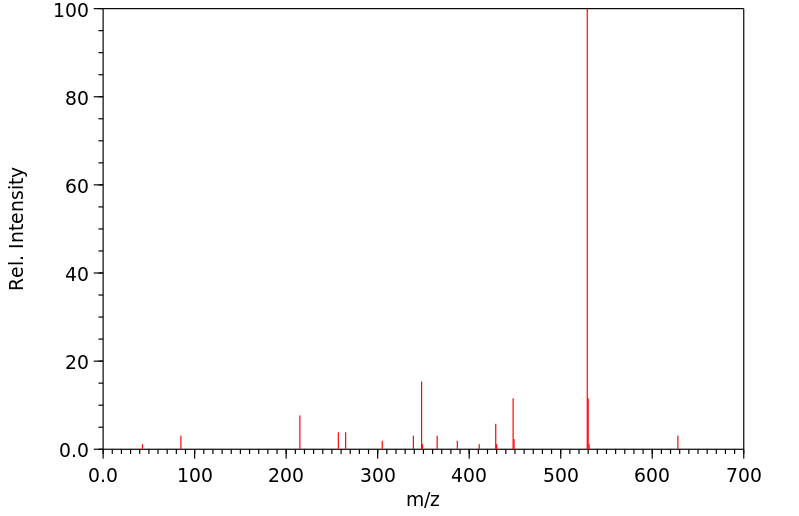tetrakis(2,4-pentanedionato)thorium(IV) | 65137-06-6
中文名称
——
中文别名
——
英文名称
tetrakis(2,4-pentanedionato)thorium(IV)
英文别名
thorium acetylacetonate;(Z)-4-oxopent-2-en-2-olate;thorium(4+)
CAS
65137-06-6;17499-48-8
化学式
C20H28O8Th
mdl
——
分子量
628.476
InChiKey
QIKPSCXIBWMTCH-MTOQALJVSA-J
BEILSTEIN
——
EINECS
——
-
物化性质
-
计算性质
-
ADMET
-
安全信息
-
SDS
-
制备方法与用途
-
上下游信息
-
文献信息
-
表征谱图
-
同类化合物
-
相关功能分类
-
相关结构分类
计算性质
-
辛醇/水分配系数(LogP):-0.64
-
重原子数:29
-
可旋转键数:4
-
环数:0.0
-
sp3杂化的碳原子比例:0.4
-
拓扑面积:161
-
氢给体数:0
-
氢受体数:8
反应信息
-
作为反应物:描述:tetrakis(2,4-pentanedionato)thorium(IV) 以 苯 为溶剂, 生成参考文献:名称:Allard, B., Acta Chemica Scandinavica, Series A: Physical and Inorganic Chemistry, 1976, vol. 30, p. 461 - 467摘要:DOI:
-
作为产物:描述:参考文献:名称:四(乙酰丙酮)钍(IV)与游离乙酰丙酮在CD3CN和CDCl3中的配体交换反应动力学摘要:1H NMR研究了四(乙酰丙酮合)钍(IV)与游离乙酰丙酮在CD3CN和CDCl3中的配体交换反应动力学。速率定律写为 rate =k[Th(acac)4][Hacac]enol,其中 k=(1.0±0.1)×102 s−1 mol−1 kg at 0 °C in CD3CN and (1.7±0.1) ×102 s−1 mol−1 kg 在 -16 °C 的 CDCl3 中。该速率通过添加碱而延迟,并且延迟效果与碱的供体数量密切相关。在研究的条件下,激活熵给出了很大的负值。提出了通过九配位中间体的配体交换机制来解释动力学规律。DOI:10.1246/bcsj.57.1576
文献信息
-
The direct electrochemical synthesis of neutral and anionic complexes of thorium(IV)作者:N. Kumar、Dennis G. TuckDOI:10.1139/v82-371日期:1982.10.15The electrochemical oxidation of thorium into solutions of halogen (X2; X = Cl, Br) in acetonitrile yields the adducts ThX4•4CH3CN in good yield. With solutions of X2 + R4NX, the products are (R4N)2ThX6. Neutral chelate complexes such as Th(acac)4 (acac = 2,4-pentanedionate) can also be prepared in a one-step synthesis from the metal, but cationic complexes could not be obtained by electrochemical methods
-
The reactivity of the coordinated ligand in Th(IV) acetylacetonate towards protons; the characterization os ome mixed ligand complexes for the metal ion作者:M.M. Aly、A.M. El-AwadDOI:10.1016/0022-1902(80)80086-8日期:1980.1of Th(acac) with trifluoro-, trochloro-, and dichloroacetic acids in benzene (1:1 molar ratio, Hacac = acetylacetone) led to the substitution of one of the coordinated ligands by the haloacetate. The acetato complex (acac) Th(CO2CH3)Cl2·4H2O was formed from a similar reaction with monochloroacetic acid (1:2). Decomposition of the coordinated acetylacetonate in the Th(IV) complex to acetate ions wasTh(acac)与三氟乙酸,三氯乙酸和二氯乙酸在苯中的摩尔比(1:1摩尔比,Hacac =乙酰丙酮)导致卤代乙酸酯取代了配位体之一。乙酸络合物(acac)Th(CO 2 CH 3)Cl 2 ·4H 2 O由与一氯乙酸(1:2)的类似反应形成。Th(IV)配合物中的配位乙酰丙酮分解为乙酸根离子是通过与吡啶甲酸(HPC)在乙醇(1:1和1:1)中反应形成配合物(acac)Th(CO 2)而产生的。 CH 3)2(PC)·H 2 O和(acac)2 Th(CO 2 CH 3)(PC)·2H 2 O,而当反应物的摩尔比为1:3时,(acac)被(PC)取代。吡啶2,6-二羧酸(H 2 pdc)与Th(acac)4在乙醇(1:1)中的反应导致形成了混合的乙酰基络合物(pdc)Th(CO 2 CH 3)2 ·4H 2在后者的复合物的协调乙酸盐的O.一个通过任一或三氯乙酸(PC)取代的和两者乙酸盐通过在
-
Synthesis, Structure, and Magnetic Behavior of a Series of Trinuclear Schiff Base Complexes of 5f (U<sup>IV</sup>, Th<sup>IV</sup>) and 3d (Cu<sup>II</sup>, Zn<sup>II</sup>) Ions作者:Lionel Salmon、Pierre Thuéry、Eric Rivière、Michel EphritikhineDOI:10.1021/ic0512375日期:2006.1.14-butanediamine (i = 9); x = 0 or 1]. The crystal structures show that the central U(IV) ion adopts the same dodecahedral configuration in all of these compounds, while the Cu(II) ion coordination geometry and the Cu...U distance vary with the length of the diimino chain of the Schiff base ligand L(i). These geometrical parameters have a major influence on the magnetic properties of the complexes. For the smallest[M(H(2)L(i))](M = Cu,Zn)和U(acac)(4)在回流吡啶中的反应生成三核复合物[[ML(i)(py)(x) ](2)U] [L(i)= N,N'-双(3-羟基水杨基)-R,R = 1,2-乙二胺(i = 1),2-甲基-1,2-丙二胺(i = 2),1,2-环己二胺(i = 3),1,2-苯二胺(i = 4),4,5-二甲基-1,2-苯二胺(i = 5),1,3-丙二胺(i = 6),2,2-二甲基-1,3-丙二胺(i = 7),2-氨基-苄胺(i = 8)或1,4-丁二胺(i = 9);x = 0或1]。晶体结构表明,在所有这些化合物中,中心U(IV)离子均采用相同的十二面体构型,而Cu(II)离子的配位几何形状和Cu ... U距离随二酰亚胺基链的长度而变化。席夫碱配体L(i)。这些几何参数对配合物的磁性能有重大影响。对于最小的Cu ... U距离(i = 1-
-
Preparation and properties of trichlorobis(pentane-2,4-dionato)protactinium(V), tetrakis(1,3-diphenylpropane-1,3-dionato)protactinium(IV), and tetrakis(pentane-2,4-dionato)actinoid(IV) complexes作者:David Brown、Brian Whittaker、John TaconDOI:10.1039/dt9750000034日期:——cation) have been unsuccessful. X-Ray diffraction results are reported for the above complexes, together with details of conditions necessary for formation of the α and β phases of the tetrakis(pentane-2,4-dionato)actinoid(IV) complexes. Solid-state spectral results (0·5–2·2 µm) are provided for β-[Pa(pd)4], β-[U(pd)4], β-[Pu(pd)4], and [Pu(pd)3] together with i.r. results for these complexes, those of由五氯化pro与戊烷-2,4-二酮(Hpd)在二氯甲烷中的反应制得三氯双(戊烷-2,4-二价)act(V),[PaCl 3(pd)2 ]。 Pa(dppd)4 ]和[Pa(dp)4 ](dppd = 1,3-二苯基丙烷-1,3-dionato)来自涉及适当螯合物的al盐和[Et 4 N] 2 [PaCl 6 ]的反应和无水非水溶剂中分别加入PaCl 4和PaCl 4。在Hpd存在下,在溶剂(例如苯和乙醇)中氧化[Pu(pd)3 ]会生成[Pu(pd)4 ]。尝试准备[Am(pd)4]和类型为M [Th(pd)5 ](M =单价阳离子)的络合物均未成功。报道了上述配合物的X射线衍射结果,以及形成四(戊烷-2,4-二氢呋喃基)肌动蛋白(IV)配合物的α和β相所必需的条件的细节。提供了β-[Pa(pd)4 ],β-[U(pd)4 ],β-[Pu(pd)4 ]和[[ Pu(pd)3 ]以及ir结果,这些配合物类型为[M(pd)4
-
Deuterium Isotope Effect on the Rate of Ligand Exchange between Tetrakis(acetylacetonato)thorium(IV) and Free Acetylacetone in CD<sub>3</sub>CN作者:Naoshi Fujiwara、Tomoe Nakagawa、Hiroshi Tomiyasu、Hiroshi FukutomiDOI:10.1246/bcsj.62.2087日期:1989.6A deuterium isotope effect on the rate of acetylacetonate exchange between tetrakis(acetylacetonato)thorium(IV), Th(acac)4, and free acetylacetone in CD3CN has been examined by means of 1H NMR technique. The second-order rate constant, k, which is expressed as a function of the observed first-order rate constant, kobsd, and the concentration of acetylacetone in the enol form, [acetylacetone]enol, by
表征谱图
-
氢谱1HNMR
-
质谱MS
-
碳谱13CNMR
-
红外IR
-
拉曼Raman
-
峰位数据
-
峰位匹配
-
表征信息
同类化合物
(反式)-4-壬烯醛
(s)-2,3-二羟基丙酸甲酯
([1-(甲氧基甲基)-1H-1,2,4-三唑-5-基](苯基)甲酮)
(Z)-4-辛烯醛
(S)-氨基甲酸酯β-D-O-葡糖醛酸
(S)-3-(((2,2-二氟-1-羟基-7-(甲基磺酰基)-2,3-二氢-1H-茚满-4-基)氧基)-5-氟苄腈
(R)-氨基甲酸酯β-D-O-葡糖醛酸
(5,5-二甲基-2-(哌啶-2-基)环己烷-1,3-二酮)
(2,5-二氟苯基)-4-哌啶基-甲酮
龙胆苦苷
龙胆二糖甲乙酮氰醇(P)
龙胆二糖丙酮氰醇(P)
龙胆三糖
龙涎酮
齐罗硅酮
齐留通beta-D-葡糖苷酸
鼠李糖
黑芥子苷单钾盐
黑海棉酸钠盐
黑木金合欢素
黑曲霉三糖
黑介子苷
黄尿酸8-O-葡糖苷
麻西那霉素II
麦迪霉素
麦芽糖脎
麦芽糖基海藻糖
麦芽糖1-磷酸酯
麦芽糖
麦芽四糖醇
麦芽四糖
麦芽十糖
麦芽六糖
麦芽五糖水合物
麦芽五糖
麦芽五糖
麦芽五糖
麦芽三糖醇
麦芽三糖
麦芽三糖
麦芽三塘水合
麦芽七糖水合物
麦芽七糖
麦法朵
麦可酚酸-酰基-Β-D-葡糖苷酸
麦利查咪
麝香酮
鹤草酚
鸢尾酚酮 3-C-beta-D-吡喃葡萄糖苷
鸡矢藤苷








